Graduate Students Visit Concrete Elementary!
On January 17th, graduate students in the 17th Cohort visited Concrete Elementary School to teach naturalist lessons. As part of our Curriculum Design course, our main goal was to engage the local community in lessons about the environment, and develop a stronger connection with the school and its teachers.
This Curriculum course is taught by Lindsey MacDonald, the Graduate Program Coordinator at the North Cascades Institute. She strategically designed this experience as a way for us grads to practice our coursework in a meaningful way.
In her own words:
Graduate students have been learning about, analyzing, and developing curricula from a theoretical, and lived experience, perspective throughout this course. This opportunity to co-develop and implement a lesson in Concrete served to ground theory in practice, engage with our neighbors, and just have a little bit of fun with real live kiddos. It can be easy to forget why we spend so much time developing and adapting curricula. These practical teaching experiences provide a good reminder of the value and impact of all the behind-the-scenes, detail-oriented work.
For a few weeks leading up to our visit, we worked in teaching pairs to write our own lesson plans from scratch, incorporating Next Generation Science Standards for the assigned grade levels. We communicated with teachers and gathered as many fun props and animal specimens as we could find in our Sundew Collections to share with students. The results? The kids had a great time and we gained more teaching experience!
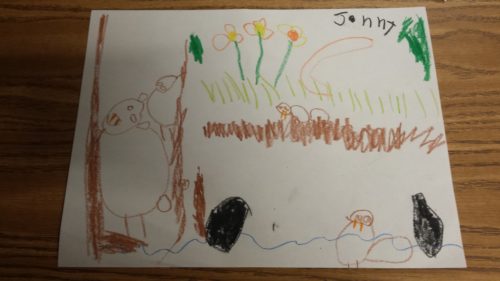
A student’s drawing of beavers in a wetland; photo by Eric Buher
Each teaching pair visited a classroom and taught for about an hour, sharing fun facts about the North Cascades Ecosystems, watersheds, and local animals. Below, Eric Buher shares his account of the day.
“It was such a pleasure to meet the wonderful students in Ms. Beazizo’s Kindergarten class at Concrete Elementary. They were very excited to learn about beavers and their habitat. They went to great efforts to show how much they had learned with some excellent pictures. We learned a lot about meeting the students where they are, the importance of effective lesson planning, and always being sure to give encouragement for burgeoning artistic talent!”
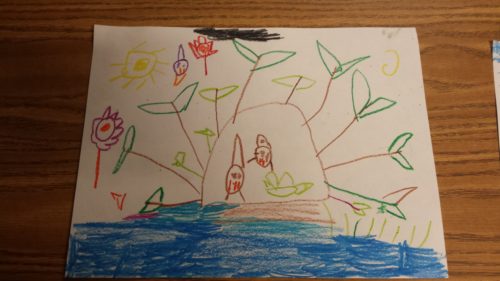
Another drawing of beavers and their lodge, or home, by a student; photo by Eric Buher
Gina Roberti and Nate Trachte visited Mrs. Wings’ first grade class, and taught ecological concepts from an age-appropriate lens through games and drawings.
Below is Gina’s experience:
“In our lesson, we took a bobcat pelt that was skinned and prepared by Cohort 15 graduate student Holli Watne. Our lesson focused on “interdependence.” We first asked students to draw a map of everything they depend upon/are connected to (the photograph of the green drawings), then brought out the bobcat pelt and brainstormed things the bobcat needed to live (what was it connected to? what do bobcats depend on?).
Finally we ended with the Project Learning Tree “web of life” activity, in which each student was assigned an aspect of the local ecosystem and connected to other students by yarn. They loved it!”

Gina Roberti and Nate Trachte pose with their first grade class and students’ drawings
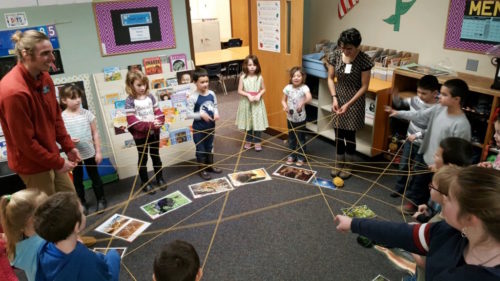
Nate Trachte and Gina Roberti play the “web of life” game – it was a ton of fun for the kids!
One of my favorite quotes came from Darcy Page’s experience in Mrs. Colwell’s first grade class. When she reenacted the scene in person, I could totally imagine an enthusiastic 6-year-old waving his hand in the air, excited to share what he knows.
Darcy’s story:
“One of the first questions I asked [to the first grade class] was if anyone knew what a predator animal was. The boy I called on responded with, “We have hair and skin and all teachers are girls!” This was a surprise. Obviously we had a ways to go to teach this new (predator/prey) vocabulary.”
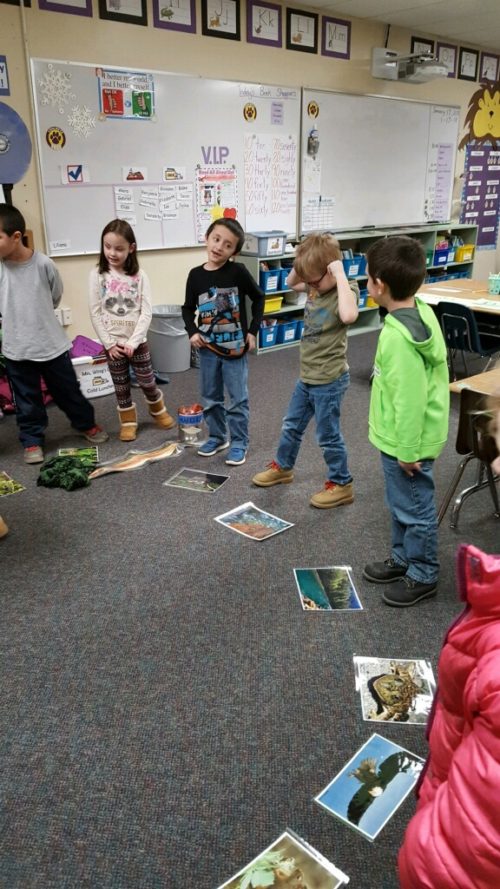
Mrs. Wings class learns about how all things are interconnected
Liz Grewal provided great insight into what kindergarteners are developmentally capable of in her Concrete Lesson Reflection writing assignment. She co-taught with Amy Sanchez and focused on watersheds. Though it was their first time teaching such a young age, they both did their best and the kids had fun!
Liz’s take:
“My time in Mrs. Henderson’s kindergarten class was a wonderful learning experience for me. I enjoyed working with the young students… I was thankful to have Amy (Sanchez) by my side during this lesson. She has a wonderful ability to break topics or concepts down into ways that the students can understand. One way Amy was able to do this particularly well was in her use of vocabulary. She was clear in the way she broke down a watershed and used the simplest terms that was able to get the concept across.”
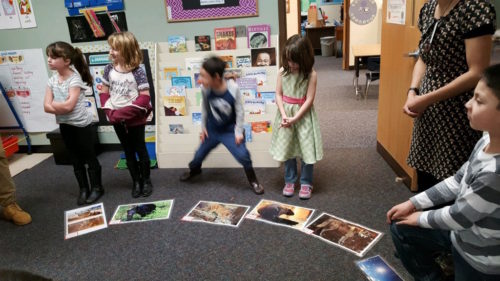
Amy Sanchez:
“I had a lot of fun… I felt like the actual lesson aligned with the lesson plan really well. My watershed model provided the kids with access to think about watersheds in a variety of learning styles. The biggest surprise was the length of time that the lesson took. Part of the reason why it took longer than I anticipated, was because I realized that keeping them engaged during the reading of Go Home, River was going to take more than just reading them the story.
So, I asked some of our assessment questions along the way and tried to make sure that I made it clear what concepts I wanted them to pay attention to. I wasn’t planning on asking them questions during the story, but I thought that reinforcing the concepts during that process was important. Repetition ended up being key with this age group.”
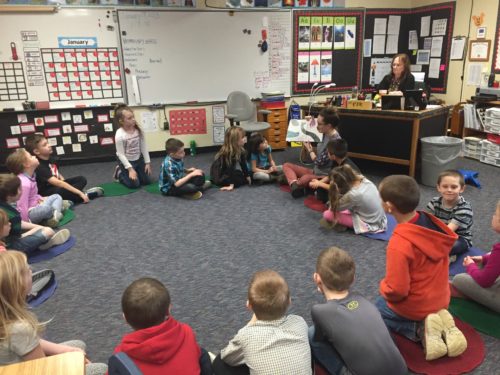
Ashley Hill reads Mrs. Riehl’s class a story to conclude our lesson on local animal adaptations
Above is a photo of Ashley Hill reading a book on animal adaptations to Mrs. Riehl’s second grade class. I, Montana, taught alongside her and think the lesson flowed well and captivated the kiddos! Can’t you tell from this picture that Ashley is a great educator? Her passion for storytelling is apparent, and she was very energetic and fun during the “movement game” activity in our lesson.
Now, Ashley’s thoughts on the experience:
“Working with the second graders at Concrete Elementary School was a breath of fresh, fun air in the middle of a chilly winter. The students were engaged every step of the way as my co-teacher and I talked about animal adaptations. We thoroughly enjoyed playing games that related different adaptations to movement. Learning kinesthetically is great for instructors and students!”
From the bottom of our hearts, the 17th Cohort of graduate students at the North Cascades Institute would like to thank you, Concrete Elementary teachers, for allowing us time in your classrooms, and the opportunity to share environmental education with your children!
Mrs. Henderson, Mrs. Beazizo, Mrs. Colwell, Mrs. Wings, Mrs. Riehl, Mrs. Roozen, and Miss Mapes – your students are AWESOME, and we at the Institute hope to see most of them again for Mountain School! (when they’re in the fifth grade of course…)
Thank you!

